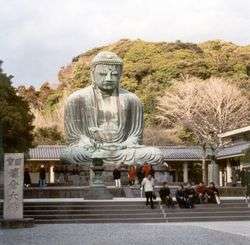鎌倉
Chinese
| scythe; sickle | barn; granary; storehouse; cabin; hold (in ship) | ||
|---|---|---|---|
| trad. (鎌倉/鐮倉) | 鎌/鐮 | 倉 | |
| simp. (镰仓) | 镰 | 仓 | |
Etymology
Orthographic borrowing from Japanese 鎌倉 (Kamakura).
Pronunciation
Japanese
| Kanji in this term | |
|---|---|
| 鎌 | 倉 |
| かま Grade: S |
くら Grade: 4 |
| kun’yomi | |
| ateji (当て字) | |
Etymology
From Old Japanese 鎌倉 (Kamakura).
Originally a compound of 竈 (kama, “oven”) + 鞍 (kura, “saddle”), from the way that the landscape as viewed from the sea looks like a saddle inside an oven, that is, a flat area in the mountains, surrounded by hills in the shape of an old traditional oven.[1]
The kanji spelling appears to be an example of ateji (当て字), literally "sickle warehouse".
Proper noun
鎌倉 (hiragana かまくら, rōmaji Kamakura)
- a placename, especially:
- Short for 鎌倉市 (Kamakura-shi): a city in the southeast of Kanagawa Prefecture of Japan; the capital city of the Kamakura shogunate
- Short for 鎌倉郡 (Kamakura-gun): a district in central Sagami Province, today part of Kanagawa Prefecture
- 931–938, Wamyō Ruijushō, book 15, page 214-215:[3]
- 鎌倉郡 加末久良 按萬葉集作可麻久良...
- (please add an English translation of this usage example)
- 931–938, Wamyō Ruijushō, book 15, page 214-215:[3]
- a surname
Derived terms
Derived terms
- 鎌倉尼五山 (Kamakura Amagosan)
- 鎌倉伊吹 (Kamakura ibuki)
- 鎌倉右大臣 (Kamakura Udaijin)
- 鎌倉海老 (Kamakura ebi)
- 鎌倉大番役 (Kamakura Ōban'yaku)
- 鎌倉海棠 (Kamakura kaidō)
- 鎌倉街道, 鎌倉海道 (Kamakura-kaidō)
- 鎌倉河岸 (Kamakura-gashi)
- 鎌倉宮 (Kamakura-gū)
- 鎌倉公方 (Kamakura Kubō)
- 鎌倉声 (Kamakura-goe)
- 鎌倉五山 (Kamakura Gosan)
- 鎌倉御所 (Kamakura gosho)
- 鎌倉柴胡 (Kamakura saiko)
- 鎌倉下げ緒 (Kamakura sageo)
- 鎌倉三代記 (Kamakura Sandaiki)
- 鎌倉三老 (Kamakura Sanrō)
- 鎌倉時代 (Kamakura jidai)
- 鎌倉大仏 (Kamakura Daibutsu)
- 鎌倉漬け (Kamakura-zuke)
- 鎌倉殿 (Kamakura-dono)
- 鎌倉七口 (Kamakura nanakuchi)
- 鎌倉幕府 (Kamakura bakufu)
- 鎌倉八幡宮 (Kamakura Hachimangū)
- 鎌倉番衆 (Kamakura banshū)
- 鎌倉飛脚 (Kamakura Hikyaku)
- 鎌倉檜葉 (Kamakura hiba)
- 鎌倉府 (Kamakura-fu)
- 鎌倉仏教 (Kamakura bukkyō)
- 鎌倉武士 (Kamakura bushi)
- 鎌倉節 (Kamakura-bushi)
- 鎌倉文化 (Kamakura bunka)
- 鎌倉彫 (Kamakura-bori)
- 鎌倉武者 (Kamakura musha)
- 鎌倉焼き (Kamakura-yaki)
- 鎌倉様 (Kamakura yō)
- いざ鎌倉 (iza Kamakura)
References
- 1988, 国語大辞典(新装版) (Kokugo Dai Jiten, Revised Edition) (in Japanese), Tōkyō: Shogakukan
- 2006, 大辞林 (Daijirin), Third Edition (in Japanese), Tōkyō: Sanseidō, →ISBN
- Minamoto, Shitagō; Kyōto Daigaku Bungakubu Kokugogaku Kokubungaku Kenkyūshitu (934–938) Shohon Shūsei Wamyō Ruijushō: Gaihen, Kyōto: Rinsen, published 1966, →ISBN, pages 203–204.
Old Japanese
Etymology
Originally a compound of 竈 (kama, “oven”) + 鞍 (kura, “saddle”), from the way that the landscape as viewed from the sea looks like a saddle inside an oven, that is, a flat area in the mountains, surrounded by hills in the shape of an old traditional oven.[1]
Proper noun
鎌倉 (Kamakura) (kana かまくら)
- a placename on the southeastern part of modern Kanagawa Prefecture
- 711–712, Kojiki (second scroll, Yamato Takeru no mikoto)[2]
- 足鏡別王者、【鎌倉之別、小津、石代之別、漁田之別祖也。】次息長田別王之子、杙俣長田子王。
- (please add an English translation of this usage example)
- c. 759, Man'yōshū (book 14, poem 3365),[3], text here
- 可麻久良乃美胡之能佐吉能伊波久叡乃伎美我久由倍伎己許呂波母多自
- Kamakura no2 Mi1go1si-no2-saki1 no2 ipakuye no2 ki1mi1 ga kuyube2ki1 ko2ko2ro2 pa motazi
- (please add an English translation of this usage example)
- c. 759, Man'yōshū (book 20, poem 4330),[4] text here
- 奈尓波都尓余曾比余比弖気布能比夜伊田弖麻可良武美流波ゝ奈之尓 右一首、鎌倉郡上丁丸子連多麻呂。
- Nanipa-tu ni yo2so2pi1 yo2so2pi1te ke2pu no2 pi1 ya idete-makaramu mi1ru papa nasi ni (Hidari isshu, Kamakura-gun jōtei Maroko no Muraji Ōmaro)
- Today in Naniwa Bay, adorned [with flags], I depart without a mother seeing me off (by the leader Maroko no Omaro from the district of Kamakura).
- 711–712, Kojiki (second scroll, Yamato Takeru no mikoto)[2]
Derived terms
- 鎌倉山 (Kamakura-yama)
Descendants
- Japanese: 鎌倉 (かまくら, Kamakura)
References
- 1988, 国語大辞典(新装版) (Kokugo Dai Jiten, Revised Edition) (in Japanese), Tōkyō: Shogakukan
- Kurano, Kenji; Yūkichi Takeda (712) Nihon Koten Bungaku Taikei 1: Kojiki, Tōkyō: Iwanami Shoten, published 1958, →ISBN, page 224
- Satake, Akihiro; Hideo Yamada; Rikio Kudō; Masao Ōtani; Yoshiyuki Yamazaki (c. 759) Shin Nihon Koten Bungaku Taikei 3: Man’yōshū 3 (in Japanese), Tōkyō: Iwanami Shoten, published 2002, →ISBN.
- Satake, Akihiro; Hideo Yamada; Rikio Kudō; Masao Ōtani; Yoshiyuki Yamazaki (c. 759) Shin Nihon Koten Bungaku Taikei 4: Man’yōshū 4 (in Japanese), Tōkyō: Iwanami Shoten, published 2003, →ISBN.
This article is issued from
Wiktionary.
The text is licensed under Creative
Commons - Attribution - Sharealike.
Additional terms may apply for the media files.
